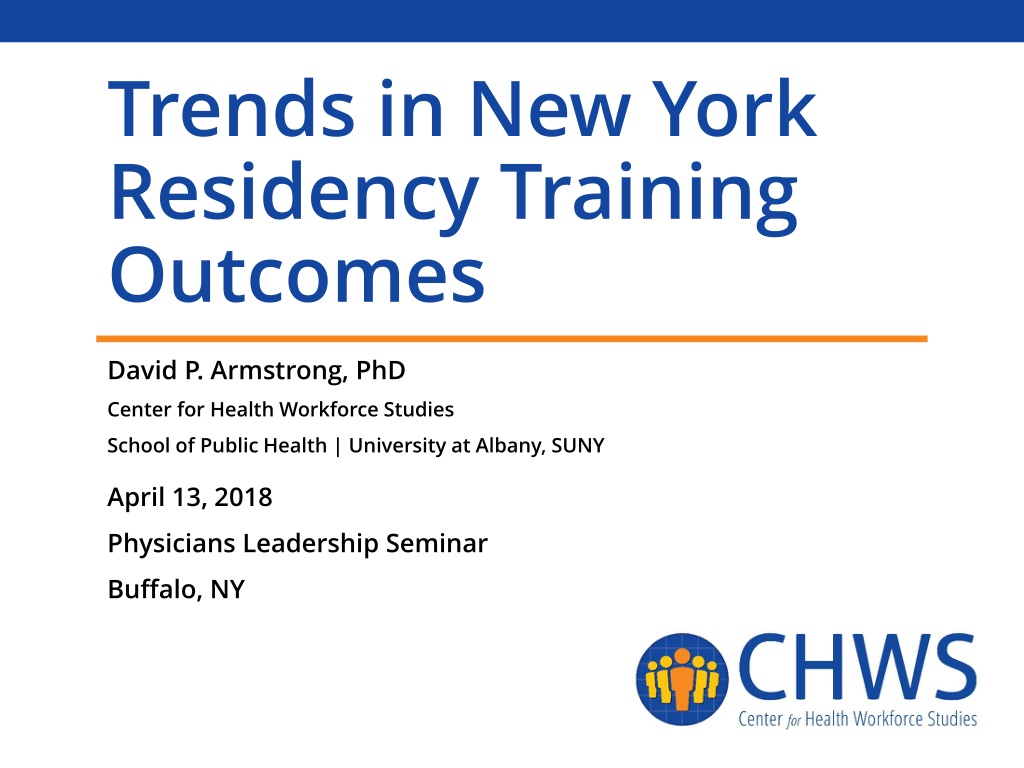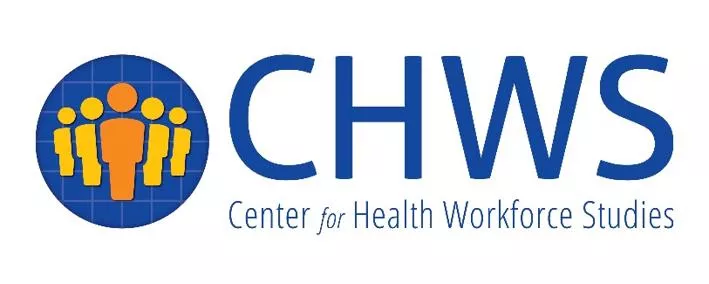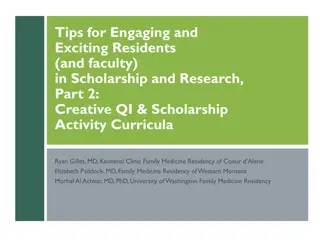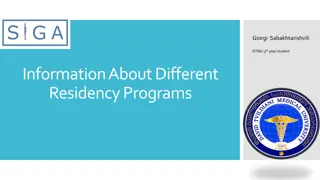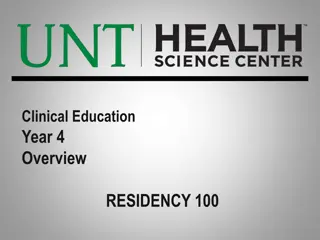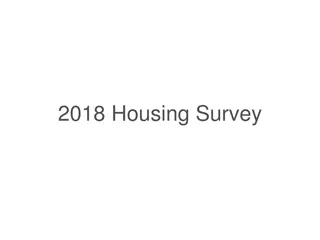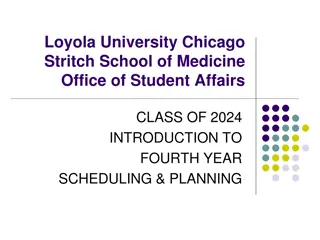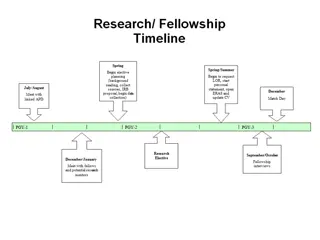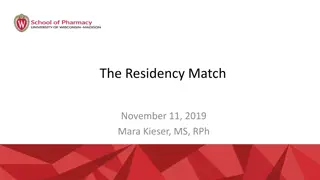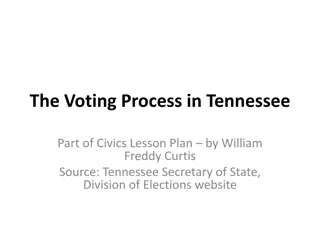Trends in New York Residency Training Outcomes
The Center for Health Workforce Studies at the University at Albany, SUNY, focuses on providing data and conducting research about the health workforce to inform public policies and sectors. The New York Physician Workforce data from 2014 shows insights into the number of physicians, their specialties, practice settings, demographics, and sources of training.
Download Presentation

Please find below an Image/Link to download the presentation.
The content on the website is provided AS IS for your information and personal use only. It may not be sold, licensed, or shared on other websites without obtaining consent from the author.If you encounter any issues during the download, it is possible that the publisher has removed the file from their server.
You are allowed to download the files provided on this website for personal or commercial use, subject to the condition that they are used lawfully. All files are the property of their respective owners.
The content on the website is provided AS IS for your information and personal use only. It may not be sold, licensed, or shared on other websites without obtaining consent from the author.
E N D
Presentation Transcript
Trends in New York Residency Training Outcomes David P. Armstrong, PhD Center for Health Workforce Studies School of Public Health | University at Albany, SUNY April 13, 2018 Physicians Leadership Seminar Buffalo, NY www.chwsny.org
Center for Health Workforce Studies Based at the School of Public Health at the University at Albany, SUNY Not-for-profit academic research center Mission: To provide timely, accurate data and conduct policy-relevant research about the health workforce Goal: To inform public policies, the health and education sectors, and the public Center was founded in July, 1996 www.chwsny.org 2
The New York Physician Workforce, 2014 New York 72,969 51 34% 9% Number of Physicians Average Age Percent Female Percent Underrepresented Minority Principal Practice Setting Solo Group Hospital Other 25% 33% 31% 10% Underrepresented Minorities (URMs) include Blacks/African Americans, Hispanic/Latinos, and American Indians/Alaska Natives Data source: New York Physician Re-registration Survey (1995-2014) www.chwsny.org 3
Physician Specialties Specialty Group Primary Care Non-Primary Care Ob/Gyn IM Specialties General Surgery Surgical Specialties Facility Based Psychiatry Total Counts 22,171 50,798 3,874 10,667 1,798 8,849 8,523 6,302 72,969 Per 100k Pop. 114 261 20 55 9 45 44 32 374 % 30% 70% 5% 15% 2% 12% 12% 9% 100% Facility Based Specialties include Anesthesiology, Radiology, and Pathology www.chwsny.org 4
The Distribution of Physicians in New York www.chwsny.org 5
Where do they come from? NY Physician Workforce 33% Percent International Medical Graduate Percent NY Medical Graduate Percent with Residency Training in NY 40% 77% www.chwsny.org 6
GME in the U.S. and New York In the US there are almost 10,000 programs and more than 120,000 residents In New York there are more than 1,100 programs and almost 16,000 residents o12% of all programs and 13% of all residents in the US are in New York California trains the 2nd highest number of physicians oAlmost 11,000 annually (or about 5,000 fewer than New York) www.chwsny.org 7
The New York Resident Exit Survey Conducted annually since 1998 (except for 2004 and 2006) A survey of all residents and fellows completing training in New York (approximately 5,000 annually) Substantial support and assistance from GME directors and programs directors Average annual response rate greater than 60% www.chwsny.org 8
The Present and Future New York Physician Workforce NY Physician Workforce Percent Female Percent URM Principal Practice Setting Solo Group Hospital Other NY Residents/Fellows, 2016 48% 16% 34% 9% 25% 33% 31% 10% 1% 40% 51% 8% www.chwsny.org 9
Monitoring the New York Physician Workforce NY Residents/Fellows, 1998 36% 13% NY Residents/Fellows, 2016 48% 16% Percent Female Percent URM Principal Practice Setting Solo Group Hospital Other 4% 47% 31% 8% 1% 40% 51% 8% www.chwsny.org 10
Retention of New Physicians after Completing Training in New York www.chwsny.org 11
Instate Retention of Physicians Completing Training in NY www.chwsny.org 12
In-State Retention by High School Location, Medical School Location, and Citizenship Status www.chwsny.org 13
Principal Reasons for Practicing Outside of New York www.chwsny.org 14
Most Influential Incentive Received for Accepting a Practice Position www.chwsny.org 15
What Job Characteristics are Important to Newly-trained Physicians? www.chwsny.org 16
Importance of Job Characteristics Not at all Important Of little importance Very Important Important Predictable start and end time each workday Length of each workday Frequency of overnight calls Frequency of weekend duties 2.4% 7.6% 51.5% 38.5% 1.4% 10.4% 52.0% 36.2% 2.0% 5.4% 43.1% 49.5% 2.3% 6.2% 43.5% 49.5% www.chwsny.org 17
Very Important Job Characteristics by Gender and Race/Ethnicity Female Male URMs Non-URMs Predictable start and end time each workday Length of each workday Frequency of overnight calls Frequency of weekend duties 43.5%* 33.3% 43.6% 37.6% 41.5%* 30.9% 40.2% 35.5% 54.2%* 44.7% 53.6% 48.8% 53.0%* 43.0% 50.8% 47.6% * p < .05 for t-test www.chwsny.org 18
Very Important Job Characteristics by Relationship Status and Dependent Children Married/ Long-term Relationship No Single/ Divorced Dependent Children Dependent Children Predictable start and end time each workday Length of each workday Frequency of overnight calls Frequency of weekend duties 40.2%* 29.6% 43.3%* 35.7% 37.5%* 29.6% 39.9%* 34.1% 50.2% 46.2% 52.5% 47.8% 49.0% 43.2% 51.8%* 45.9% * p < .05 for t-test www.chwsny.org 19
Do Job Characteristics Influence Medical Specialty Choice? Predictable start and end time each workday 43.5%* 38.0% Length of each workday 42.0%* 31.0% Frequency of overnight calls 56.8%* 45.1% Frequency of weekend duties 54.8%* 49.3% Primary Care (n=336) Ob/Gyn (n=71) Medicine Subspecialties (n=200) Surgical Specs (n=100) Facility Based (n=122) Psychiatry (n=92) Other (n=275) 36.0% 32.0% 49.0% 45.5% 22.0%* 33.6% 56.5%* 36.4% 20.0%* 27.9%* 57.6%* 36.0% 29.0%* 39.3%* 71.7%* 46.5% 31.0%* 44.3% 69.6%* 42.2%* * p < .05 for t-test (eg, primary care compared to non-primary care specialties, ob/gyn compared to non-ob/gyn specialties, etc.) www.chwsny.org 20
Trends in Job Market Demand for Newly-trained Physicians www.chwsny.org 21
Measuring Relative Demand by Specialty Difficulty finding a satisfactory practice position Changing plans due to limited practice opportunities Number of job offers Assessment of regional job market Assessment of national job market Change in starting income over time www.chwsny.org 22
Difficulty Finding a Satisfactory Practice Position www.chwsny.org 23
Changing Plans Due to Limited Practice Opportunities www.chwsny.org 24
Job Offers Received www.chwsny.org 25
Assessment of Regional Job Market www.chwsny.org 26
Assessment of National Job Market www.chwsny.org 27
Starting Salaries www.chwsny.org 28
The Relative Demand for Primary Care Physicians Has Surpassed Specialists www.chwsny.org 29
Relative Demand by Individual Specialty Highest Relative Demand oFamily Medicine oEmergency Medicine oGeneral Internal Medicine Lowest Relative Demand oPathology oRadiology oPediatric Subspecialties www.chwsny.org 30
Trends in Physician Income www.chwsny.org 31
Physician Income Median starting salary in 2016: $233,500 Physician income has increased over time (even after taking into account inflation) Gender differences in physician income over time oAdjusting for specialty, setting, patient care hours, practice location, age, race/ethnicity, citizenship status, type of medical education, and inflation www.chwsny.org 32
Gender Differences in New Physician Income have Increased Over Time www.chwsny.org 33
Gender Differences in Physician Income by Primary Care Specialties, 2014-2016 Income Difference -$20,134 -$15,214 -$2,759 -$12,697 Significance .0001 .0000 .0000 .0001 Family Medicine General IM General Pediatrics Obstetrics/Gynecology Negative dollars indicate that females earn less than males www.chwsny.org 34
Conclusions www.chwsny.org 35
Summary Proximity to family and one s hometown greatly influences the practice location of newly-trained physicians Job characteristics that lead to a more manageable lifestyle are considered either important or very important to more than 85% of newly-trained physicians The demand for primary care physicians has increased substantially over the last 20 years relative to specialists Gender differences in physician income have increased over time despite more women entering medicine www.chwsny.org 36
Contact Information David P. Armstrong dparmstrong@albany.edu School of Public Health | University at Albany, SUNY 1 University Place, Ste 220 | Rensselaer, NY 12144 (p) 518.402.2551 | (f) 518.402.0252 www.chwsny.org 37
